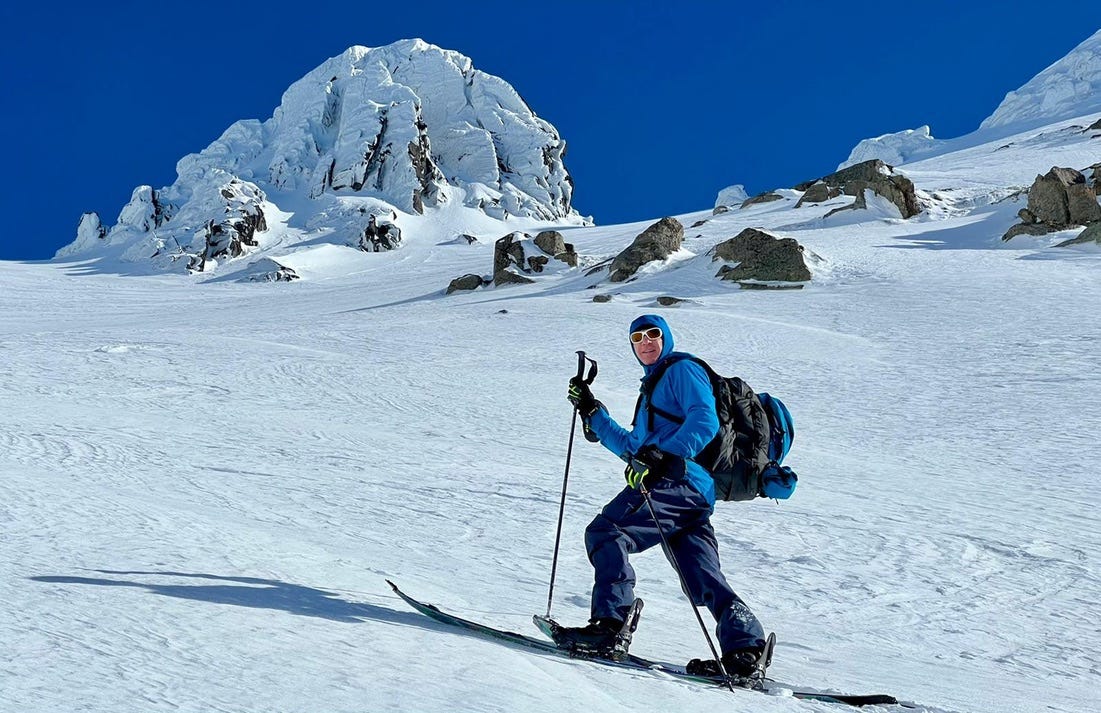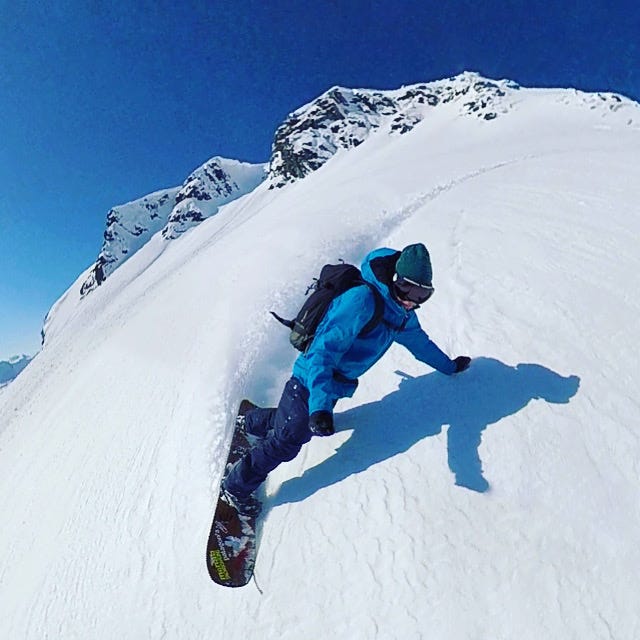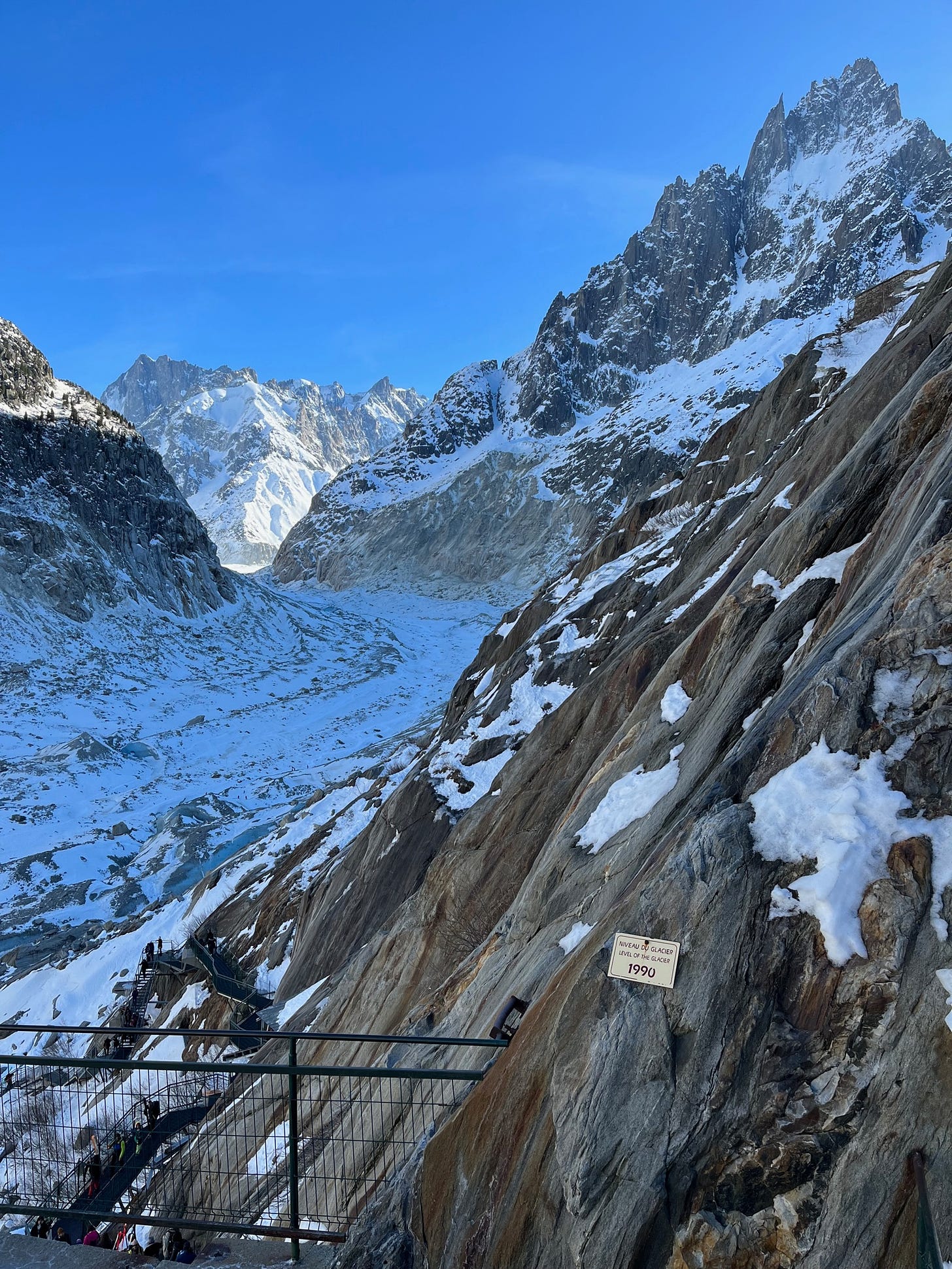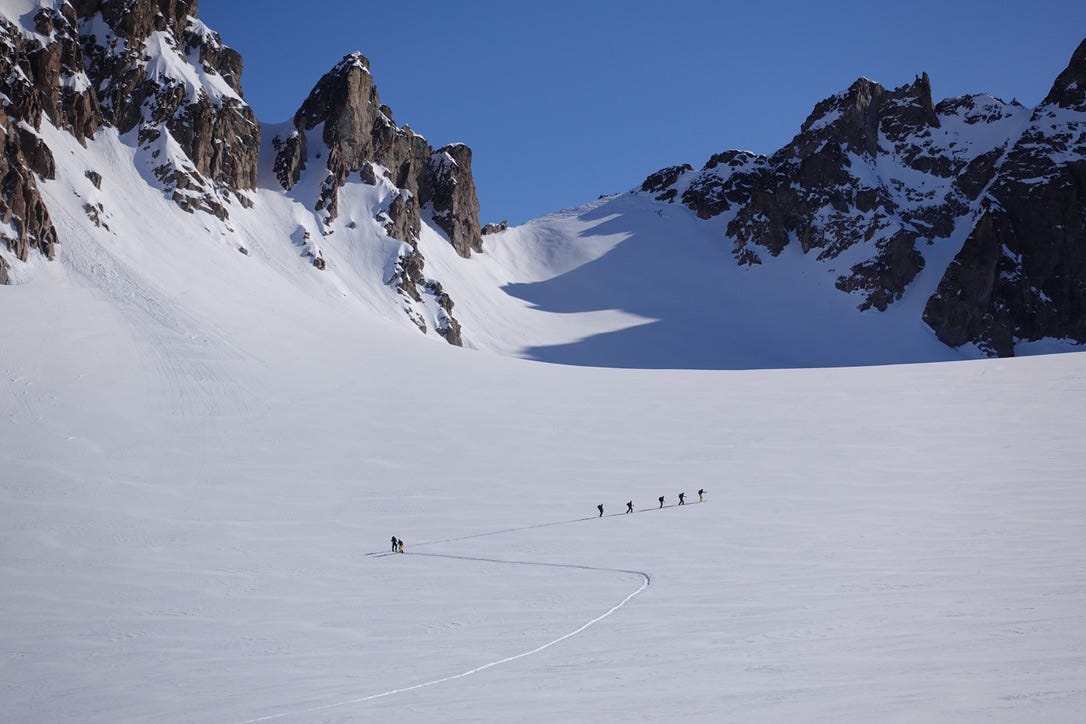“I used to go heliboarding, but I don’t anymore since it became apparent we have to change our ways.”
An interview with high mountain guide and backcountry snowboard specialist Neil McNab, who lived in Chamonix for 20 years
“I used to go heliboarding, but I don’t anymore since it became apparent we have to change our ways. I’ve changed many things in terms of how I live my life and work. I still need to drive to some places and fly every now and then, but I don’t do long-haul. There are a lot of things that I don’t do which I used to take for granted.”
At the start of March, Neil McNab, a high mountain guide and backcountry snow specialist, wrote a post on Instagram about the current state of the Vallee Blanche and Mer de Glace in Chamonix, a place where he’s guided clients for over 20 years. I was in Chamonix myself last month and shocked at the pace of glacial retreat since I lived there in 2001, so I thought it would be good to interview Neil about it all and how it has impacted his role as a guide.
Neil lives in SW France now, but still returns to Chamonix to guide for much of the season. He also takes clients to the Pyrenees, Lofoten Islands and Lyngen Alps in Norway. I hope you enjoy our chat.
Hey Neil, how are the waves at the moment?
Good, I just had a little surf, it was lovely.
You lived and worked as a high mountain guide in Chamonix for over 20 years, before moving to south-west France in 2017. What prompted that move?
It was time for a change, and I felt like I’d seen the best of it. I’d been there in my prime climbing, skiing, and snowboarding, and also the conditions suited more what I was doing then. There was always good snow in the winter and good climbing in the summer, and now there is very rarely good snow in the winter and very rarely good conditions in the summer. It was a hard place to live, knowing what it had been like compared to what it’s like now.
And living in the mountains generally is hard, the summer and winter seasons are really intense. Autumn and spring are the really nice periods but you’re preparing for the next thing all the time.
How has guiding changed since the early 2000s?
Things used to be a lot more predictable. You could plan things, and know the conditions were going to be good here, the exit to this descent would be good there and so on. Now things change so fast, a lot of the routes we used to do are impassable now and the amount of places we can go to is reduced.
10 years ago, we started to notice the changes but since then it’s really accelerated. Routes that would have been beginner Alpine climbs are now impossible, they’re too dangerous or have rocks falling down, or the snow and ice just isn’t there anymore.
In winter, the snowpack is not as deep as it used to be, so it melts out quickly, and that snow was what protected the glaciers in summer. 10 years ago, we’d never get down to the glacier ice in summer, in say the Vallee Blanche you’d still be walking on winter snow, whereas now very early on in the summer that snow is gone. And once you get to the glacier ice on the surface it melts really quickly.
When do you remember first talking about the climate crisis?
I’ve been in the mountains since the late 1980s and I think I started to become aware of it about 10 years ago, before then, I’d probably heard of it but didn’t see it and didn’t really change my actions. I used to go heliboarding, but I don’t anymore since it became apparent that we have to change our ways. I’ve changed many things in terms of how I live my life and work. I still need to drive to some places and fly every now and then, but I don’t do long-haul. There are a lot of things that I don’t do which I used to take for granted.
I lived in ignorance for quite a long time and even if I was probably aware of the changes I was seeing, I didn’t see it as a long-term thing, I didn’t see it as changing so fast as it has done now.
We started guiding Mont Blanc in the summer around 2000 and for 10 years there wasn’t an issue, maybe every now and then there would be a bit of rockfall in the Grand Couloir but not really. But during the last 10 years half the time you go there you turn around, and the last two years they’ve actually shut it.
There are routes that used to be in condition all summer that will be in condition maybe in the spring or maybe just before winter in the autumn. These are absolute classics that we used to do every week.
Does it make it more stressful to be a guide?
Definitely. You might have planned a week in the winter and then totally have to change your plans. I just ran two courses in Chamonix and when I got there it was the worst conditions I’ve ever seen, so we had to spend the whole week in Italy. Everyday you’re waking up and making a decision as to where you can go.
It used to be: “Where would be the best place to go?” Now it’s: “Where can I go?”
But all we can do now is to be adaptable. And if you go somewhere and the conditions aren’t good it’s our fault, we’ve done this [to the planet] so we should just accept it and get on with it.
You recently posted about the state of the Mer de Glace. I was there in February and it’s almost a site of mourning for me now, thinking about how it’s changed over the last 20 years…
It’s incredible, isn’t it? When you look at the plaques on the wall that tell you how high the ice was. In 2000, which is when I first guided it, we were coming off the ice at that point and now you look at the void below. You can hardly even imagine what it was like. In the summer, we used to ice climb on the Mer de Glace at the bottom of the ladder but there’s no ice there now. It’s really sad. Looking across to Pas de Chevre, you’d need a paraglider to get out the bottom now.
How have your clients responded to it all?
Somehow, I’ve still been able to find good conditions for them and good snow, but I have to think it out a lot. The clients are happy to be out in the mountains and doing what we’re doing, and I always try and get them the best I can get them, but it’s definitely harder. Some of them have been coming out for 20 years so they’ve seen the changes too.
Most of my regular clients are definitely of the same mindset as me and we do talk about it and share this mutual respect for the environment and the planet. It’s something I definitely try to put across in what I’m doing. And they continue to come even though I don’t take them heliboarding anymore. We splitboard and walk everywhere and they appreciate it. And the ones that don’t, can find someone else to take them heliboarding.
Heliboarding feels like it’s in quite bad taste to me now…
You’ve got to make your choices and decisions, we’re not all living climate-friendly lives, and I’m not criticising anyone that does it, it’s just a decision I’ve made.
Splitboarding is great for getting in touch with nature instead of just charging…
Yes definitely. Walking up, you’re earning your place up there, being part of the mountain and appreciating the environment. If you just fly in there and jump out of a helicopter and ride down, it’s almost disrespectful in a way. Hiking up you’re also seeing what the conditions are like and making your decisions step by step, it feels like you’re more in tune with the mountains and you get the rewards on the way down.
Have you enjoyed exploring the Pyrenees more?
Yes, it’s really wild, unlike the Alps, there are valleys with nothing in them, no houses or anything. The first winter I went they had amazing conditions and there was nobody there, even in the resorts in the week. You’d be on the lift and there would be 6-7cm of fresh snow on the piste.
But then it changes quickly too, the next week it might rain or whatever, but it does that in the Alps now too. I also really like the layout of the terrain. In the Alps you have the bit at the top that’s had too much wind, the bit at the bottom that’s too warm and the bit in the middle that is just right, the Pyrenees is that bit in the middle is the mountain, so when you get it right you ride the whole thing.
To find out more about Neil and his backcountry courses head here. He’s also on Instagram & runs twice-weekly zoom yoga classes for outdoor athletes.
Other news:
I wrote about my own experience of how Chamonix has changed in the last 20 years and how guides are adapting for the Guardian here.
For Raconteur, I wrote about B Corps and why bringing multinationals on board might not be such a bad thing, which you can read here, & the French academic who encourages businesses to embrace altruism, which you can read here.
Please fwd this newsletter to anyone who you think might be interested & if you have any story tips on any of these themes pls get in touch.






Hey Steve, course yep that’s fine with me, thanks for sharing it
hey sam let me know if you are happy for us to re post this to our website - will keep all the pledge links in